 The Guernsey Tapestry, currently displayed in a purpose built gallery in St James Concert Hall, is a fascinating artefact, crafted by the whole community. It was conceived as a Millennium project in 1995 and grew into a Bailiwick wide community project.
The Guernsey Tapestry, currently displayed in a purpose built gallery in St James Concert Hall, is a fascinating artefact, crafted by the whole community. It was conceived as a Millennium project in 1995 and grew into a Bailiwick wide community project.
Visually appealing, technically excellent and educationally valuable, the Tapestry and its’ accompanying texts teaches not only our Islands history but also art, craft, and design, whilst illustrating the value of community spirit, dedication and planning.
THE IDEA IN THE MAKING
The colours of the panels are designed to change gradually through the centuries, from the Norman greys through to the vibrant chemical colours of the Victorian era.
The tapestry itself depicts events in the Bailiwick of Guernsey over the last 1000 years. It comprises 10 panels each covering 100 years. Extensive research was done by local historians who provided a century by century breakdown of important events along with information on culture and costume.
From this research pencil sketches followed by pen drawings and finally full colour designs were drawn up and approved by the comittee overseeing the project. The colours of the panels were purposely designed to change gradually through the centuries, from the Norman greys through to soft browns and vegetable dyes and on to the vibrant chemical colours of the Victorian era.
As so much time is covered in the ten designs many events are written around the borders of each panel. These are documented in Guernesiais (Guernsey French), until the 19th century panel when English is used.
WORK BEGINS
The artwork was taken to a local company which scanned the paintings and enlarged each one to finished panel size, 4’x3′ (1.22m x .91m), on to an underlying grid. This grid was marked out in sixteen lines to the inch, to correspond to the sixteen holes per inch of the canvas used. Using this as a guide the canvas was marked out with the outlines of the design. The scanned design was also used by the stitchers as a guide.
The longevity of the Tapestry was considered from its conception so the best quality canvas and yarns were used, with the light fastness of the yarn being of paramount importance.
a tapestry made by the people of the Bailiwick, for the people of the Bailiwick
Notices went to Women’s Institutes and Church groups, in fact anyone who enjoyed stitching, and there was an overwhelming response. It was decided that as there are ten parishes on the Island each parish should be allocated a panel to stitch, which made the organisation much easier. The majority of stitching was done by a core of 211 stitchers. They worked a three and a half day week in two hourly shifts from 9 am – 4 pm for almost three years.
Tapestry Factoids
- Although the panels are referred to as tapestries they are actually embroidered canvas work. A tapestry in
the strictest sense of the word is woven.
- There are over 12 varieties of stiches used in the tapestry (plus a few created to suit the purpose)
- The stitches have bene used to create quite distinctive textures which enhance the colour and design and add depth.
- The Tapestries have been put into the hands of a Trust which holds them on behalf of the people of the Bailiwick of Guernsey.
The first two panels were started in September 1996 with the remaining panels were started at varying intervals over the next two years.
As well as the core of regular stitchers the panels were taken to different venues to enable as many islanders as possible to put their stitches in. The whole idea was that this was to be a community project – a tapestry made by the people of the Bailiwick, for the people of the Bailiwick.
THE TAPESTRY FINDS A HOME
In February 1999 the Bailiwick of Guernsey Millennium Tapestry was declared by the States of Guernsey as one of two official Millennium projects. As such a grant of £300,000 was made to provide a purpose built gallery for the Tapestry. This was extremely important because the type of textile used needed to be kept in a purpose built environment to prevent deterioration.
With the grant the panels were able to be displayed in individual cases which provide a controlled environment where they are protected from potentially damaging light and at a constant temperature and humidity.
THE TAPESTRY PANELS

Panel 1 : 11th Century (1001-1100)
The panel begins by depicting scenes from before the year 1000 and continues up to the end of
the 11th century
On the upper right of the panel stands La Gran’mere du Chimquiere, the grandmother of the
cemetery. A prehistoric stone statue at least 4000 years old. She is probably a pagan symbol of
fertility and still stands at the entrance to St Martin’s Church. Behind her is Le Trepied Dolmen, built in the a Bronze Age between 3000 and 2000 BC, which can still be seen today in St Saviour.
The Iron Age warrior on the upper left is based on a warrior discovered during an archaeological dig in Kings Road. St Peter Port, buried with his lance, shield and sword as shown.
The monk shown standing in front of the mansion on Herm is St Tugual, the Welsh saint who is believed to have visited the Channel Islands around 540 AD. The mediaeval chapel on Herm is dedicated to him.
The ship at the centre of the panel is based on the remains of a Gallo-Roman trading vessel salvaged from the seabed at the entrance to St Peter Port harbour. The wreck was named Asterix by the archaeological recovery team.
This panel was stitched by the parishioners of St Martin.

Panel 2 : 12th Century (1101-1200)
Panel 2 shows a map of Guernsey detailing sites associated with folklore and of religious significance.
The island had been divided into ten parishes for about 600 years at this point. Most of the parishes take their names from the Saints to whom their churches are dedicated and these parish churches are represented by yellow crosses on the map. Grey crosses indicate priories, such as on Lihou Island, and chapels.
Areas particularly associated with apparitions are marked with the animal form that they took. At Les Hubits in St Martin the Devil is said to have appeared as a hare (Llievre). A spectral goat (La Biche), is said to haunt Les Grons and the chien bodu mentioned in the border is a black dog which haunted the Clos du Valle.
This panel was stitched by the parishioners of St Saviour.
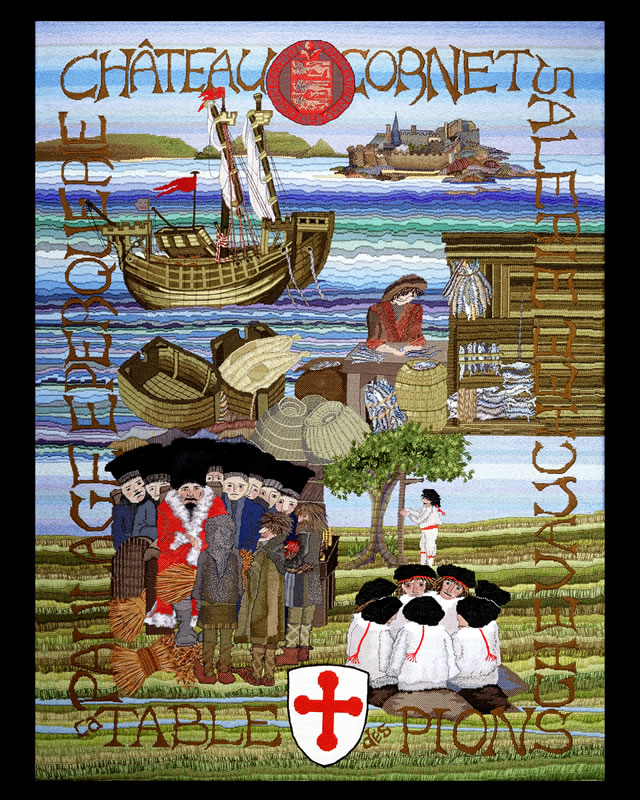
Panel 3 : 13th Century (1201-1300)
The construction of Castle Cornet (Chateau Cornet) began at the start of this century. As with many of the Island’s fortifications it was built to protect the Island from French invasion, and is shown at the top of the panel.
The Island was an important anchorage on the sea routes between England and Gascony. The boats
shown below the Castle are trading vessels from Gascony bringing wine to be matured in the cellars along the sea front. These cellars are now shops and restaurants.
The Royal Court, comprising the Bailiff and twelve jurats came into being in this century and in this panel the Court is receiving feudal dues on behalf of the King. Peasants are shown bringing their hens and sheaves of corn as taxes to the king.
This panel was stitched by the parishioners of the Vale.
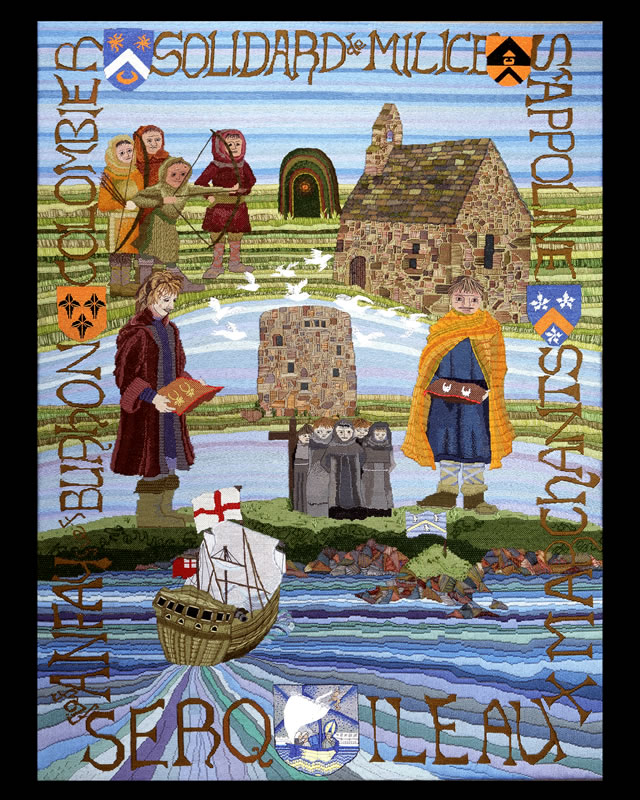
Panel 4 : 14th Century (1301-1400)
The Hundred Years War between England and France began in 1337 and King Edward III ordered the Islands’ able bodied men to form a militia for the defence of the Island. Militia Men are shown practising archery at Les Buttes.
Opposite the archers stands St Appoline’s Chapel, built in 1392 by Nicholas Henry. Situated in the parish of St Saviour it contains a number of mediaeval frescoes.
This panel was stitched by the parishioners of St Sampson.
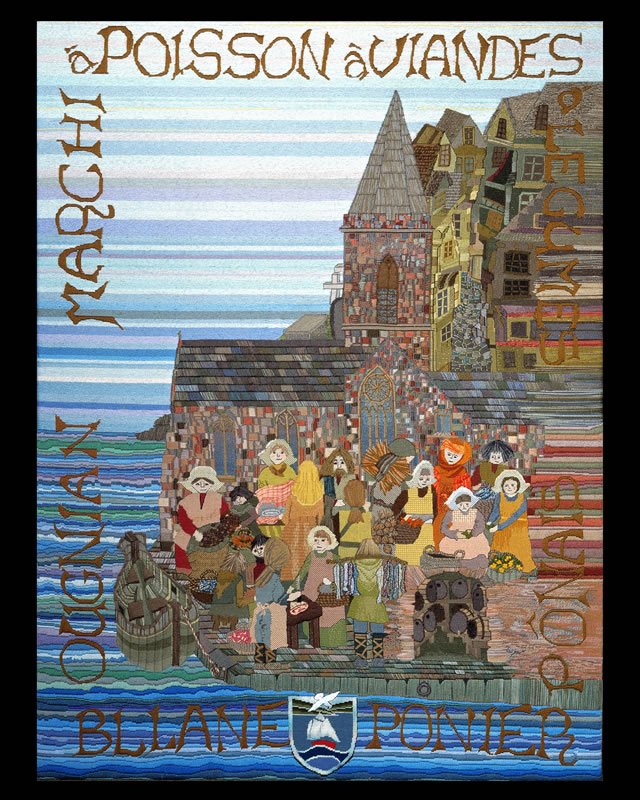
Panel 5 : 15th Century (1401-1500)
This panel shows the distinctive Norman Church is St Peter Port.
Before the market buildings existed, markets were held in the area of the present Market Square where meat, vegetables and dairy produce were sold, and the fish market was held on the south side of the parish church of St Peter Port, known as the Town Church. The words around the border, marchi a poisson a viandes a legumes, refer to these fish, meat and vegetable markets.
The Town Church was partly rebuilt and extended during this century, and the South Transept with its rose window date from this period. Behind the Church is the Cimitiere des Soeurs.
This cemetery was used by a convent of nuns, and after they left the Island it continued to be used for burials. Nowadays there is a cafe on part of the site. The hill behind the Church is Cornet Street, which was the main road out of town to the south, lined with the houses of merchants and shop keepers.
This panel was stitched by the parishioners of Torteval.
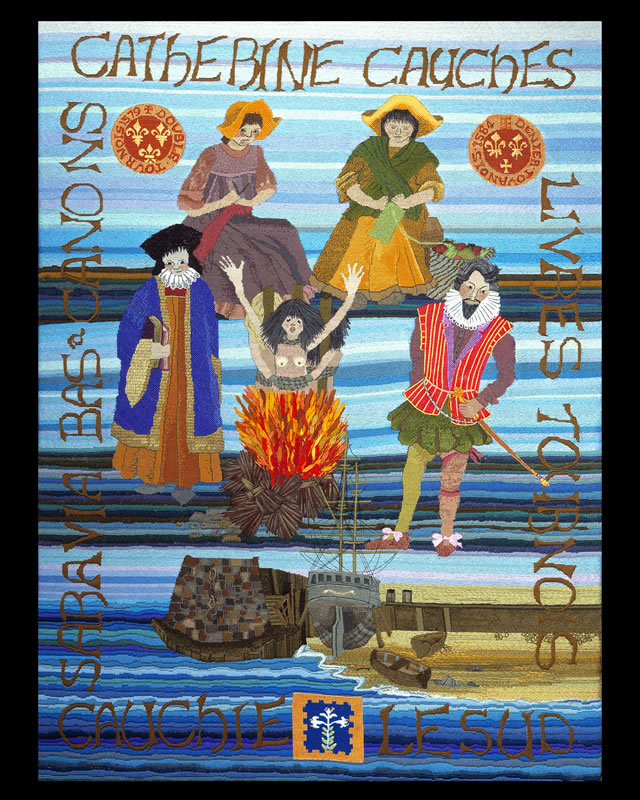
Panel 6 : 16th Century (1501-1600)
Along with the rest of Europe. Guernsey felt the changes brought about by the Reformation and during the reign of Mary 1 (1554-1558). When Roman Catholicism was briefly restored, three Protestant women were martyred for their beliefs One of them, Perotine Masse was pregnant and her baby boy was born as she was dying. He was rescued from the flames by William House, the Master Gunner and Surgeon to the garrison at Castle Cornet only to be thrown back
into the flames by the Bailiff.
Under Elizabeth I (1558-1603) the Protestant religion was restored, and Elizabeth College was founded in 1563 to encourage Protestantism in Guernsey. The first headmaster, Dr Adrian Saravia is shown to the left of the martyrs.
In 1590 the South Pier was completed. It was built out from the vicinity of the Town Church to enclose what we now call the old harbour and provided shelter and improved docking facilities. The ship shown in this harbour is a typical Elizabethan trading vessel.
This panel was stitched by the parishioners of Castel.
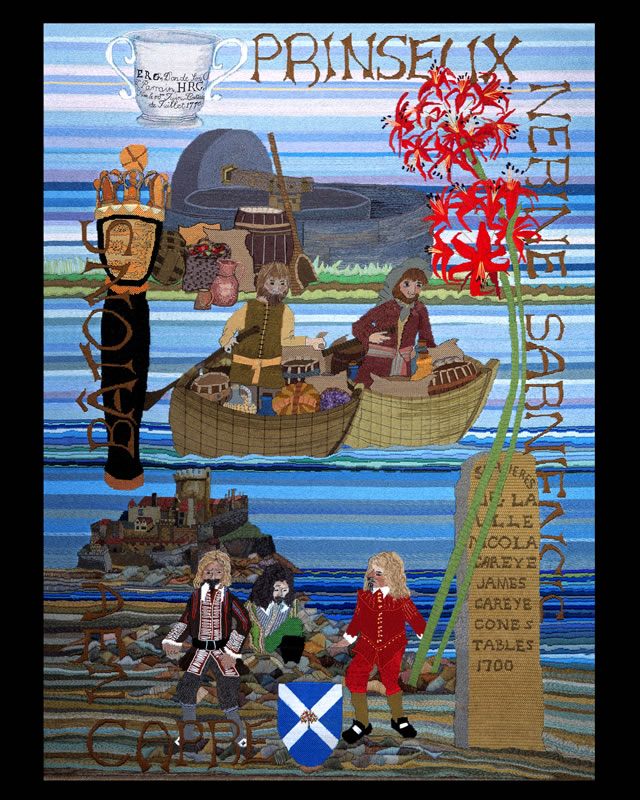
Panel 7 : 17th Century (1601-1700)
The English Civil War began in 1642 and Guernsey declared for Parliament, but the Lieutenant Governor. Sir Peter Osborne, held Castle Cornet for the King. He and his soldiers were besieged for 9 years.
In 1643 three of the Parliamentary commissioners for Guernsey, Pierre Carey, Pierre de Beauvoir and James de Havilland. were captured and imprisoned in the Castle. After six weeks they made a daring escape across the rocks to St Peter Port at low tide. The Castle was not joined to Guernsey at that time. This escape is shown at the bottom of the panel.
In the late seventeenth century war with France saw Guernsey privateers capture many French
merchant ships and in the centre of the panel privateers are shown bringing merchandise ashore in two sturdy rowing boats.
Many Guernsey farms had cider presses (prinseux), as cider was a popular drink in the days before clean water. At the top of of the panel a stone apple crusher is depicted. A horse was harnessed to the wheel. As it walked around the juice ran off and this was collected and put into barrels to mature.
The Guernsey Lily, Nerine Sarniensis, is actually a native flower of South Africais and also shown on this panel.
This panel was stitched by the parishioners of St Andrew.
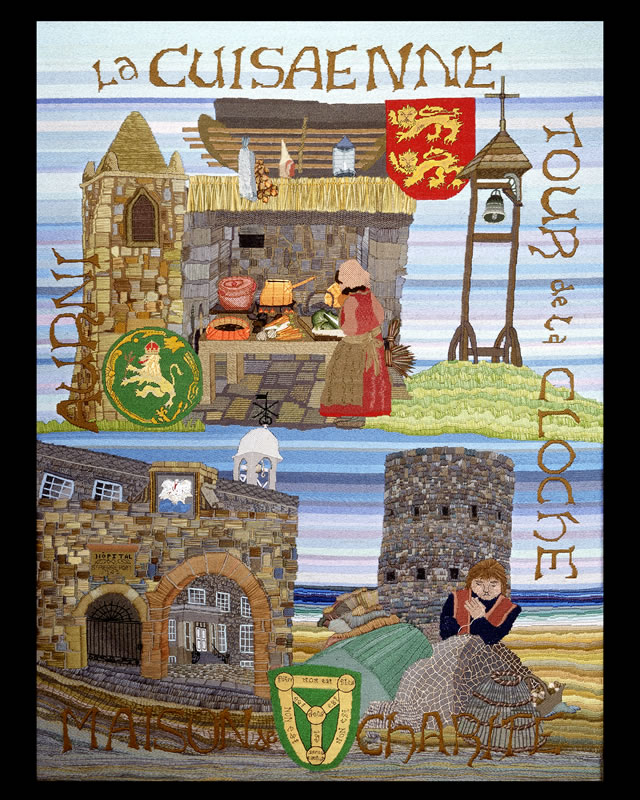
Panel 8 : 18th Century (1701-1800)
This panel deals with the domestic life of Islanders. At the top of the panel is the kitchen with a large open fireplace. A bread oven, built into the side of the hearth, was also used for roasting meat on a Sunday. The woman is shown preparing the local Guernsey delicacy ‘bean jar’.
A Guernsey fisherman mends his nets beside his upturned fishing boat.
At the bottom left is the Town Hospital which was founded in 1742 as a Maison de Charite, or House of Charity, to care for the poor of St Peter Port. It played a very important role in the domestic life of the Island for over two hundred years, and was also used as an orphanage, an infirmary, and occasionally a maternity hospital. This is now the site of the Island Police Station.
The round tower to the right of the Hospital is one of fifteen that were built in 1778 to guard the beaches of Guernsey against a landing by the French.
This panel was stitched by the parishioners of the Forest.

Panel 9 : 19th Century (1801-1900)
In this panel, three of Guernseys industries in the 19th century are represented.
At the top are the shipyards along the South Esplanade, with trading boats being built on the stocks ready to be launched into Havelet Bay. The largest vessel built in Guernsey was the 656 ton ship the ‘Golden Spur’, launched in 1864.
Below the shipyards, a man and a boy work in the quarries. Thousands of tons of Guernsey granite were exported annually to England and much of the stone was used for paving. It was also used for the steps of St Paul’s Cathedral and for the Embankment in London.
The tomatoes and grapes represent the horticultural industry with many greenhouses built after 1870 to supply fruits and vegetables to England. At first the principal crop was the grape, but after the First World War tomatoes became the main crop.
During this century there was a great deal of new building in St Peter Port and at the bottom of the panel is the new fish market which opened in 1875.
This panel was stitched by the parishioners of St Pierre du Bois.
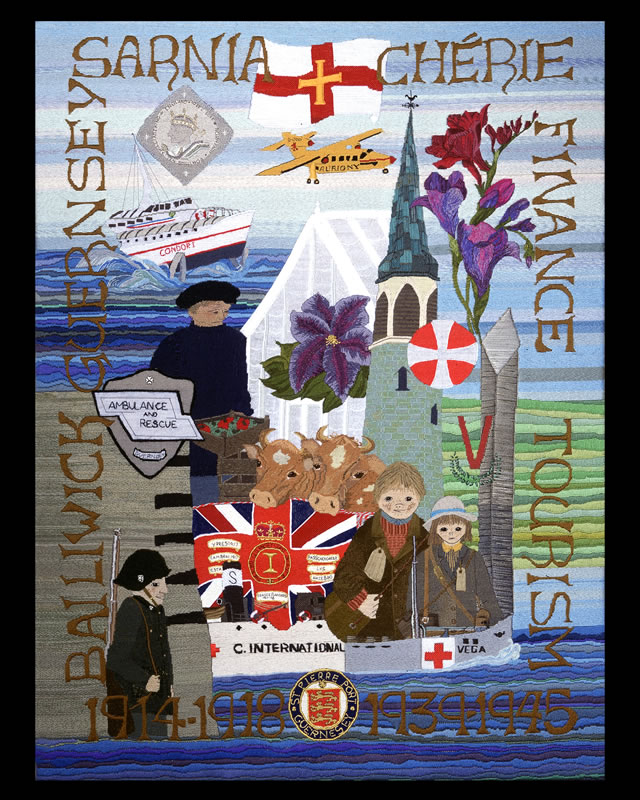
Panel 10 : 20th Century (1901-2000)
Horticulture was Guernseys main industry for much of the 20th century. This is represented by a wooden greenhouse and a worker in his traditional knitted guernsey, carrying a tray of capsicums. Also shown are freesia and clematis flowers and two of Guernsey’s famous breed of dairy cows.
This century also saw the development of tourism. In 1964 the hydrofoil Condor 1 began to operate a service between Guernsey and St Malo. Aurigny Air Services began to operate a regular service between the islands in 1968. Trilander aircraft with their bright yellow livery were introduced to the service in 1971. Joey, the aircraft shown, has a distinctive red nosecap.
Finance, the main industry at the end of the twentieth century is mentioned in the border.
During the First World War [1914-18] the Royal Guernsey Light Infantry fought on the Western Front where hundreds of young Guernsey men were killed in action. Their regimental colours are shown.
The Second World War began in 1939. As invasion became likely, in 1940, thousands of islanders were evacuated to England. They are represented by the two children. German forces occupied the Island for 5 years and built gun emplacements and observation towers around the coast. A German soldier is shown outside one of these.
This panel was stitched by the parishioners of St Peter Port.
 The Guernsey Tapestry, currently displayed in a purpose built gallery in St James Concert Hall, is a fascinating artefact, crafted by the whole community. It was conceived as a Millennium project in 1995 and grew into a Bailiwick wide community project.
The Guernsey Tapestry, currently displayed in a purpose built gallery in St James Concert Hall, is a fascinating artefact, crafted by the whole community. It was conceived as a Millennium project in 1995 and grew into a Bailiwick wide community project.














